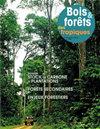更好地估计婆罗洲被砍伐的龙脑果森林的碳储量
IF 0.6
4区 农林科学
Q3 FORESTRY
引用次数: 0
摘要
热带森林是生物多样性和碳(C)的主要储存库,在全球生态系统功能和气候调节中发挥着关键作用。然而,大多数热带森林,特别是东南亚的婆罗洲森林,受到伐木、采矿业、农业和转向工业种植园等人为活动的巨大压力和威胁。2010年,婆罗洲的生产林面积为2680万公顷(约为2000万公顷)。占婆罗洲总土地面积的36%),其中包括1800万公顷(约8800万公顷)。24%)被砍伐的森林。因此,生产性森林正在成为主要的土地利用方式,在提供商品和维持生态系统服务(如碳和生物多样性保持)方面发挥着至关重要的作用。众所周知,选择性采伐通过砍伐几棵大树而减少地上和地下生物量,同时通过附带损害而增加枯木储量。通过在树冠上制造巨大的间隙,林下和森林地面的小气候发生了局部变化,加速了凋落物和有机物的分解。偶然损害程度、冠层开度和C恢复速度主要与采伐强度有关。然而,关于采伐强度对生产林碳平衡的长期影响的实证评价仍然很少。本论文旨在评估1999/2000年采伐的北婆罗洲龙果林(北加里曼丹马里瑙地区)的采伐强度对碳封存的长期影响。在不同的采伐强度梯度下(采伐初始生物量的0% ~ 57%),估算了活树、枯木、凋落物和土壤有机碳(SOC)的地上碳(AGC)和地下碳(BGC) 5个主要碳库。结果表明,采伐后16年的总碳储量在218 ~ 554 Mg C ha-1之间,平均为314 Mg C ha-1。低采伐强度之间的差异为95 Mg C ha-1(19%)。大多数C(大约)。77%),其次是土壤(15%)、枯木(6%)和小部分凋落物(1%)。采伐强度的影响在采伐16年后仍然存在,是导致AGC>20、BGC>20、枯木和总碳储量减少、枯木增加的主要原因。采伐强度分别解释了61%、63%、38%和48%的AGC>20、BGC>20、枯木和总碳储量的变化。采伐强度也显著降低了上层30 cm土壤有机碳储量。对于总SOC储量(0 ~ 100 cm),采伐强度的负影响仍然明显,且与其他变量的负影响显著。我们的研究结果量化了伐木对森林C储量的长期影响,特别是对AGC和枯木的影响。高采伐强度(初始生物量减少50%)使总碳储量减少27%。高采伐强度样地的AGC恢复较低,表明森林对采伐的恢复能力较低。研究表明,维持低于初始生物量20%的采伐强度,限制了采伐对AGC和枯木储量的长期影响。本文章由计算机程序翻译,如有差异,请以英文原文为准。
Towards better estimates of carbon stocks in Borneo's logged-over Dipterocarp forests
Tropical forests are a major reservoir of biodiversity and carbon (C), playing a pivotal role in global ecosystem function and climate regulation. However, most of the tropical forests, especially Bornean forests in Southeast Asia, are under intense pressure and threatened by anthropogenic activities such as logging, mining industry, agriculture and conversion to industrial plantation. In 2010, the area of production forests in Borneo was 26.8 million ha (approx. 36% of the total land area of Borneo) including 18 million ha (approx. 24%) of logged forests. Production forests are thus emerging as a dominant land-use, playing a crucial role in trading-off provision of goods and maintenance of ecosystem services, such as C and biodiversity retention. Selective logging is known to reduce both above- and below-ground biomass through the removal of a few large trees, while increasing deadwood stocks through collateral damages. By creating large gaps in the canopy, microclimates in the understory and on the forest floor change locally speeding up the decomposition of litter and organic matter. The extent of incidental damages, canopy openness, as well as the speed of C recovery, was shown to be primarily related to logging intensity. However, empirical evaluations of the long-term effect of logging intensity on C balance in production forests remain rare. The present thesis aims to assess the long-term effect of logging intensity on C sequestration in a north Bornean Dipterocarp forests (Malinau District, North Kalimantan) logged in 1999/2000. Five main C pools, namely above-ground (AGC) and below-ground (BGC) carbon in living trees, deadwood, litter, and soil organic carbon (SOC) were estimated along a logging intensity gradient (ranging from 0 to 57% of initial biomass removed). Our result showed that total C stocks 16 years after logging, ranged from 218-554 Mg C ha-1 with an average of 314 Mg C ha-1. A difference of 95 Mg C ha-1 was found between low logging intensity ( 19%). Most C (approx. 77%) was found in living trees, followed by soil (15%), deadwood (6%), and a minor fraction in litter (1%). The imprint of logging intensity was still detectable 16 years after logging, and logging intensity thus was the main driver explaining the reduction of AGC>20, BGC>20, deadwood, and total C stocks and an increase in deadwood. Solely, logging intensity explained 61%, 63%, 38%, and 48% of variations of AGC>20, BGC>20, deadwood, and total C stocks, respectively. Logging intensity also significantly reduced SOC stocks in the upper 30 cm layer. For total SOC stocks (0-100 cm), the negative influence of logging intensity was still perceptible, being significant in conjunction with other variables. Our results quantify the long-term effect of logging on forest C stocks, especially on AGC and deadwood. High logging intensity (50% reduction of initial biomass) reduced total C stocks by 27%. AGC recovery was lower in high logging intensity plots, suggesting lowered forest resilience to logging. Our study showed that maintaining logging intensity, below 20% of the initial biomass, limit the long-term effect of logging on AGC and deadwood stocks.
求助全文
通过发布文献求助,成功后即可免费获取论文全文。
去求助
来源期刊

Bois et Forets Des Tropiques
FORESTRY-
CiteScore
1.50
自引率
16.70%
发文量
31
审稿时长
>12 weeks
期刊介绍:
In 1947, the former Tropical Forest Technical Centre (CTFT), now part of CIRAD, created the journal Bois et Forêts des Tropiques. Since then, it has disseminated knowledge and research results on forests in intertropical and Mediterranean regions to more than sixty countries. The articles, peer evaluated and reviewed, are short, synthetic and accessible to researchers, engineers, technicians, students and decision-makers. They present original, innovative research results, inventions or discoveries. The journal publishes in an international dimension. The topics covered are of general interest and are aimed at an informed international audience.
 求助内容:
求助内容: 应助结果提醒方式:
应助结果提醒方式:


